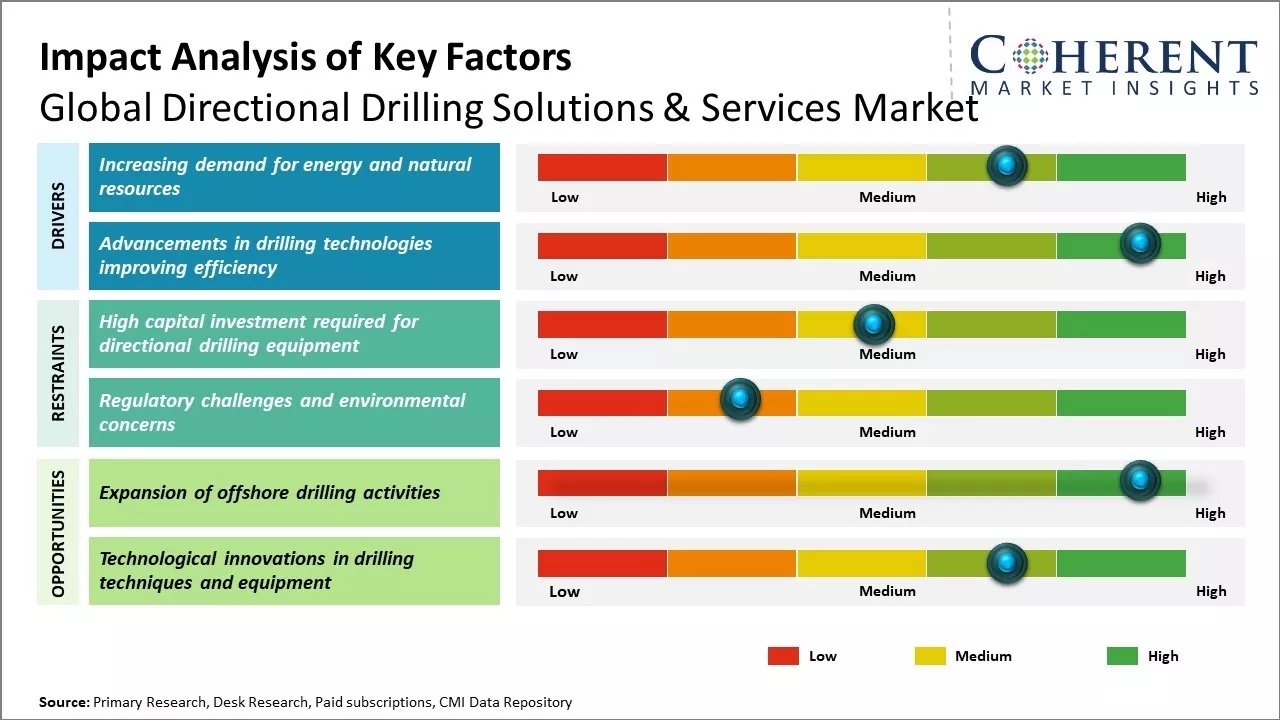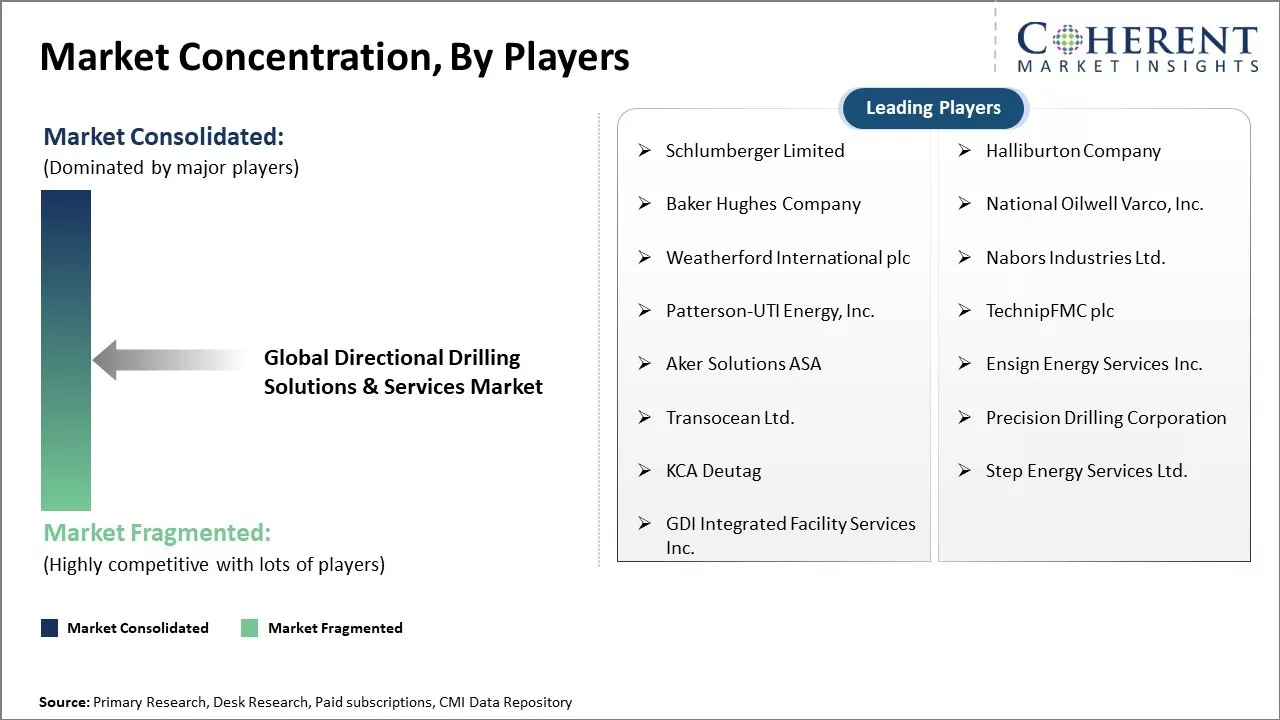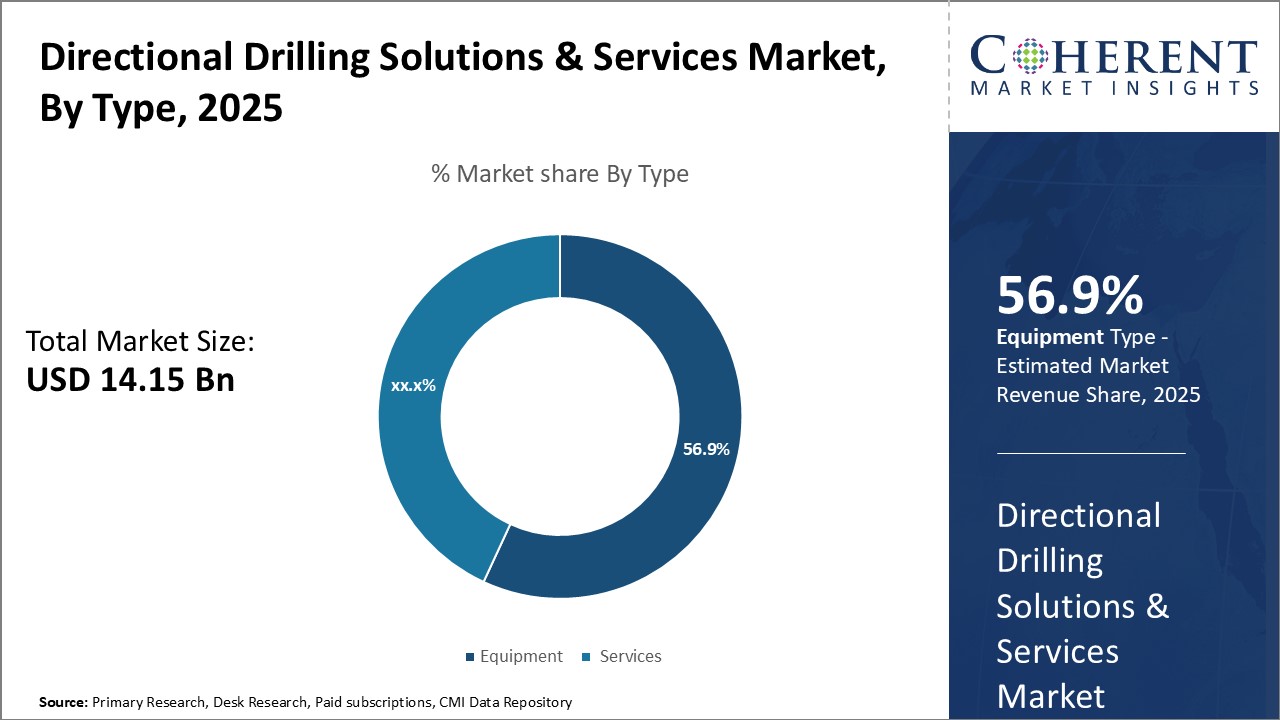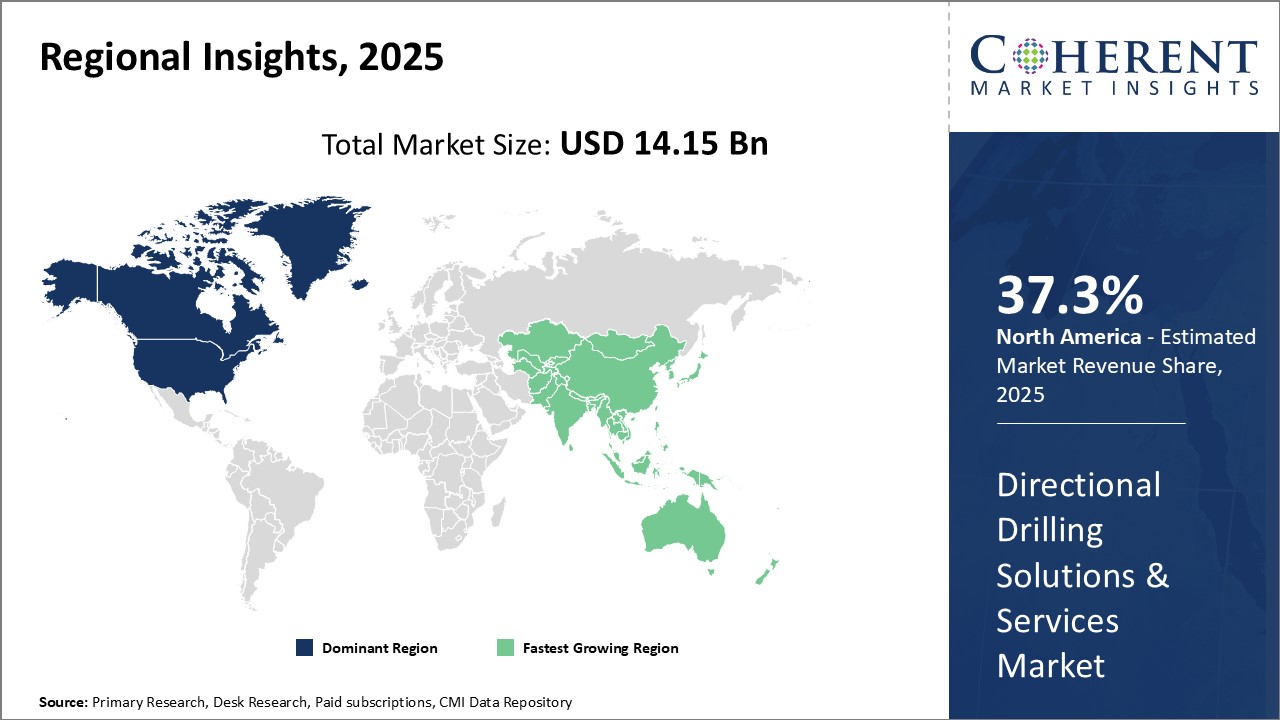Global directional drilling solutions & services market is estimated to be valued at US$ 14.15 Bn in 2025 and is expected to reach US$ 24.73 Bn by 2032, exhibiting a compound annual growth rate (CAGR) of 8.3% from 2025 to 2032.

Discover market dynamics shaping the industry: Download Free Sample
The directional drilling solutions & services market is expected to witness significant growth over the forecast period. There is growing demand for directional drilling techniques from oil & gas industry to extract oil and gas from difficult terrains and maximize production from mature fields. With increasing investment toward complex oil and gas extraction projects, the demand for directional drilling is increasing substantially. Major players such as Schlumberger Limited, Halliburton Company, Baker Hughes Company, National Oilwell Varco, Inc., Weatherford International plc, etc. in the market are focusing on incorporating advanced technologies like rotary steerable systems and logging-while-drilling to enhance efficiency and achieve maximum wellbore placement accuracy. Adoption of digital technologies to enable collection of real-time drilling data is also helping companies to reduce drilling time and costs. Increasing complexity of drilling projects and advancing technologies are boosting demand for directional drilling solutions & services during the forecast period.
Market Driver - Increasing demand for energy and natural resources
The world's consumption of energy and natural resources continue to grow each passing year with growing population and expanding economic activities. Oil and natural gas remains the lifeline of today's economy meeting a major part of world's energy needs. However, conventional extraction methods are reaching their limits and new technologies are needed to unlock reserves trapped in harder to reach locations. Directional drilling solutions allows operators to drill multiple branched boreholes from a single drill site thus minimizing surface footprint and reducing environmental impact. This becomes immensely important as drilling activity moves closer to environmentally sensitive and urban areas.
With depleting conventional reserves, there is growing focus on tapping shale and tight reserves which often require highly deviated and extended reach wells that can be precisely drilled using directional techniques. The ability to accurately steer and placed wells through narrow zones with pinpoint targeting helps maximize resource recovery. This makes directional drilling ideal for challenging applications involving shale, tight gas, deepwater reserves, and horizontally lengthy unconventional wells. The rising crude prices and energy demand incentivizes operators to look for alternatives that can boost production volumes from existing fields and previously neglected reservoirs. The proven production added and improved recovery rates through techniques like managed pressure drilling further enhances the scope of directional solutions.

Get actionable strategies to beat competition: Download Free Sample
Advancements in drilling technologies improving efficiency
Drilling technology is continuously evolving to tackle complexities posed by hard formations and optimize operations cost effectiveness. Directional drilling companies investing in R&D are introducing new instruments, sensors and software which enhances drilling outcomes. More accurate surveying, mapping and visualization helps identify downhole obstacles in advance and plan well trajectories. Automation of certain processes streamlines operations while real time positioning systems provide greater angle and depth control for building long horizontal and multilateral sections. The integration of measurement while drilling and logging while drilling technologies provides critical downhole operational intelligence. Advanced bent housing designs, improved mud motors and drill bits with advanced diamond coating extend equipment life.
New drilling fluid formulations improve wellbore stability especially in extended reach horizontal sections drilled through friable formations. The adoption of closed loop systems recovers more drilling fluids minimizing environmental footprint. The use of downhole motors driven by hydraulics eliminates the need of joints thus drilling is not interrupted during trips resulting increased rate of penetration. These advances cumulatively help drilling programs stay on schedule, optimize resource usage and lower per foot drilling costs. It makes complex projects more economically viable. The increased reliability and efficiency translate to higher cost savings for operators tapping opportunities previously considered technically infeasible.
For instance, in July 2023, Weatherford, a leading global energy services company, launched a next-generation directional drilling service aimed at increasing operational efficiency for its customers. The new service leverages Weatherford's extensive expertise in drilling technologies and its commitment to delivering innovative solutions that drive the energy industry forward.
Key Takeaways from Analyst:
Global Directional Drilling Solutions & Services market is expected to witness significant growth driven by the increasing oil and gas exploration and production activities around the world as energy demand rises. As conventional reserves decline, there is higher emphasis on tapping into tougher reserves such as shale oil and gas which will require extensive directional drilling.
North America is expected to continue dominating the market owing to major onshore and offshore projects in the U.S. and Canada. However, the Asia Pacific regions are likely to see faster growth as countries ramp up investments to meet domestic energy requirements. Within Asia Pacific, China will be a hotspot for directional drilling backed by its massive upstream investments.
Rising complexity of reservoir targets poses a challenge for operators to economical extract resources. This is expected to boost demand for technologically advanced directional drilling solutions like rotary steerable systems. Higher accuracy, longer reach and reduced drilling time offered by such solutions enhances project economics in complicated reservoirs.
While investments in directional drilling are growing, environmental regulations around well construction could act as a restraint. However, with technological progress, solutions are being introduced to minimize the environmental footprint of operations as well.
Market Challenge - High capital investment required for directional drilling equipment
Global Directional Drilling Solutions & Services market faces significant challenges due to the high capital costs associated with directional drilling equipment and tooling. Directional drilling rigs and machinery require heavy up-front investments, as the technology and tools needed to precisely drill non-vertical wellbores are complex and specialized. Motors, mud pumps, downhole motors and locators, measurement-while-drilling systems and other directional drilling tools can cost millions of dollars per rig. Additionally, constant wear and tear on downhole tools during drilling operations leads to high maintenance and replacement costs. The high fixed costs associated with directional drilling programs pose substantial barriers to entry for new competitors. Operators, particularly small and medium sized companies, may hesitate to adopt directional drilling techniques due to the significant capital outlay required. Cost pressures can limit expenditure on advanced technology upgrades and hamper innovation.
Market Opportunity - Expansion of offshore drilling activities
Global Directional Drilling Solutions & Services market stands to benefit tremendously from the expected expansion of offshore drilling activities in the coming years. With onshore reserves maturing, oil and gas companies are increasingly exploring offshore reserves which are usually located farther below the seafloor or in more geologically challenging areas. This makes directional drilling especially important for tapping into reserves located under the sea or in ultra-deepwater locations. The adoption of directional well designs allows for multiple reservoir zones to be accessed from a single drilling location, reducing costs. Nations around the world are encouraging offshore exploration to boost domestic energy production, presenting many opportunities for directional drilling contractors and solution providers. Factors like these are likely to drive healthy demand growth in the directional drilling market from offshore applications over the long run.

Discover high revenue pocket segments and roadmap to it: Download Free Sample
Insights By Type - Rising Digitalization is Fueling Equipment Demand
In terms of type, the equipment segment is estimated to contribute the highest market share of 56.9% in 2025 owing to increasing digitalization in directional drilling operations. Various new technologies such as rotary steerable systems, MWD systems, LWD systems and mud motors allow real-time management of downhole tools and offer accurate drilling trajectory. This advanced equipment provide precise formation evaluation as well as enable automated drilling processes. Adoption of automated equipment is growing since they reduce non-productive time, improve consistency and minimize human errors. Moreover, equipment manufacturers are leveraging technologies like Internet of Things, machine learning and artificial intelligence to develop smart drill rigs and intelligent tools. These smart equipment optimize drilling parameters during operations, predict failures and automate complex directional well profiles. Additionally, governments worldwide are supporting digital transformation in oilfields through funding and initiatives to promote efficient extraction of oil and gas resources. Thus, rising digitalization trends and efforts towards automation are propelling the demand for new generation directional drilling equipment.
For instance, in January 2023, National Oilwell Varco (NOV), a leading provider of equipment and technology for the oil and gas industry, expanded its manufacturing capabilities to enhance the production of directional drilling equipment. This strategic move aims to meet the growing demand for advanced drilling solutions and improve operational efficiency for its clients.
Insights By Technology - Enhanced Drilling Outcomes Foster RSS Adoption
In terms of technology, the Rotary Steerable Systems (RSS) segment is estimated to contribute the highest market share of 43.7% in 2025 owing to their ability to deliver enhanced drilling outcomes. RSS combines rotary drilling with directional steering capabilities to drill complex well profiles accurately. They provide critical advantages over conventional systems such as improved directional control, walk rate, higher rate of penetration and reduced non-productive time. Especially for long horizontal well sections, extended reach wells and deepwater drilling, RSS effectively maintains wellbore position and delivers straight or curved whole sections. Furthermore, continuous development has enhanced reliability and performance of various RSS models. Their user-friendly designs simplify operational difficulties by reducing rig crew dependency. Operators can now accurately drill complicated wellbore trajectories in challenging environments without compromising on efficiency. Consequently, RSS is widely used for applications requiring precision such as shale gas resource exploitation. Thus, superior functionality along with ongoing technological optimization on accelerates adoption of RSS systems among drillers.
Insights By Application - Dependence on Oil & Gas Spurs Growth in Application Segment
In terms of application, the oil & gas segment is estimated to contribute the highest market share of 52.6% in 2025 because of the sector's immense dependence on directional drilling techniques. A large number of oil and gas reservoirs now have declining production or are located miles beneath the earth's surface or offshore in deep waters. Directional drilling enables tapping such complex resources through long horizontal and extended reach wells, multilateral wells and more. It helps maximize reservoir contact and boosts recovery from mature fields. In the petroleum industry, directional drilling now plays a pivotal role in unconventional oil and shale gas extraction through horizontal drilling and multistage hydraulic fracturing. In offshore projects too, flexible well designs using advanced steering tools allow development of reservoirs located several miles below seas. With growing energy needs worldwide, emphasis on boosting oil supply from existing reservoirs through improved drilling drives immense uptake of directional drilling services within the oil & gas sector. In addition, rising global demand for oil and gas ensures continued spending on upstream E&P despite commodity price fluctuations. This helps secure significant revenue opportunities for directional drilling solution providers from the oil and gas application segment.

Need a Different Region or Segment? Download Free Sample
North America has established itself as the dominant force in the global Directional Drilling Solutions & Services market. The region is expected to hold 37.3% of the market share in 2025. The region is home to several industry leaders and has seen tremendous investment in upstream oil and gas exploration activities over past decades. Presence of complex reservoirs with irregular boreholes have propelled the adoption of directional drilling technologies in North America. Additionally, the shale boom has created sustained demand for services that facilitate drilling multiple horizontal and lateral wells from single drill sites. This has strengthened North America's position as the nerve center for innovation and advancements in directional drilling techniques.
The Asia Pacific region is poised to be the fastest growing market going forward. Rising energy consumption driven by robust economic growth and industrialization is increasing focus on augmenting domestic oil and gas reserves in countries like China and India. With significant untapped shale and unconventional resources estimated to be present underneath, Asia Pacific presents lucrative expansion opportunities. Further, national oil companies and private players in the region have ramped up capital spending to accelerate exploration of deepwater reserves and tight formations which require sophisticated directional drilling capabilities. This is encouraging global suppliers to foray into Asia Pacific with specialized rigs and tools. Countries are also offering incentives to encourage technology transfers and local manufacturing which will help Asia Pacific to gradually reduce its dependence on imports for directional drilling services.
Directional Drilling Solutions & Services Market Report Coverage
| Report Coverage | Details | ||
|---|---|---|---|
| Base Year: | 2024 | Market Size in 2025: | USD 14.15 Bn |
| Historical Data for: | 2020 To 2024 | Forecast Period: | 2025 To 2032 |
| Forecast Period 2025 to 2032 CAGR: | 8.3% | 2032 Value Projection: | USD 24.73 Bn |
| Geographies covered: |
|
||
| Segments covered: |
|
||
| Companies covered: |
Schlumberger Limited, Halliburton Company, Baker Hughes Company, National Oilwell Varco, Inc., Weatherford International plc, Nabors Industries Ltd., Patterson-UTI Energy, Inc., TechnipFMC plc, Aker Solutions ASA, Ensign Energy Services Inc., Transocean Ltd., Precision Drilling Corporation, KCA Deutag, Step Energy Services Ltd., and GDI Integrated Facility Services Inc. |
||
| Growth Drivers: |
|
||
| Restraints & Challenges: |
|
||
Uncover macros and micros vetted on 75+ parameters: Get instant access to report
*Definition: Global directional drilling solutions & services market provides solutions and services related to directional drilling in oil and gas industries on a global scale. It offers products and technologies that help in steering downhole tools and drill bits to hit reservoirs located nearby or at distant places. Services include measurement-while-drilling, logging-while-drilling, motors and drives, rotary steerable systems, and drilling optimization software to enable engineers to drill complex.
Share
Share
About Author
Ramprasad Bhute is a Senior Research Consultant with over 6 years of experience in market research and business consulting. He manages consulting and market research projects centered on go-to-market strategy, opportunity analysis, competitive landscape, and market size estimation and forecasting. He also advises clients on identifying and targeting absolute opportunities to penetrate untapped markets.
Missing comfort of reading report in your local language? Find your preferred language :
Transform your Strategy with Exclusive Trending Reports :
Frequently Asked Questions
Joining thousands of companies around the world committed to making the Excellent Business Solutions.
View All Our Clients